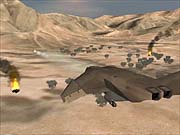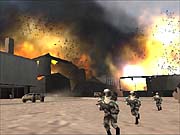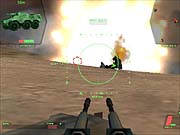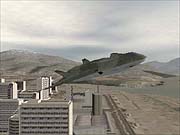Dropship: United Peace Force is the most recent product that Bam has rescued from non-release oblivion. The game was developed by SCE Europe and released by Sony in that territory earlier this year, and Bam was fortunate to pick it up for US publishing. One of the more interesting combat flight games currently available, Dropship has you piloting all sorts of powerful multipurpose VTOL (vertical takeoff and landing) aircraft. Sony's hesitance to release the game directly in North America is a bit puzzling--Dropship is a complex, engrossing game, though it can take a while to learn. However, while the game is certainly impressive on a technical level, some elements of its graphical presentation seem somewhat primitive when viewed against current standards. It loses some of its "oomph" as a result, but not by much.

Dropship presents a very interesting take on the console flight combat sim. Most of the craft you'll fly function as both fighters and transports, and most of the missions you'll take on will in turn require you to play both roles. Most of the media released for the game has showcased the largest of the craft you'll get to use, which looks and feels like a flying tugboat. Rest assured, that isn't the only ship you'll get to use. You'll have access to several different aircraft, all of which are sleeker and have more specialized roles. Most of them will indeed function as dropships, however.
Being a dropship pilot means that you'll often have to engage in combat but must also concern yourself with the ferrying of friendly units around the battlefield. The game's complex control scheme allows you to switch between two modes of flight fairly seamlessly, one of which centers around high-speed flight, and another that's meant for drop-offs, pickups, and landings. The latter is called hover mode, and while in it, your ship will move much more slowly, and you'll have the ability to increase and decrease altitude without forward motion. Once you gain enough velocity, you'll enter flight mode, though you can switch back to the hover mode at will by pressing the square button twice in quick succession. Conversely, hitting the X button twice while in hover mode will trigger a quick boost in velocity. In both modes, thrusts are accomplished by means of the X button, while "brakes" are relegated to the square button. These functions are analog-sensitive, too, so jamming down on X or square will activate your afterburners and a stronger air brake, respectively.

The flight mode controls much like that of any other combat flight sim. The left stick controls your pitch and roll, while the L2 and R2 buttons adjust your yaw. The hover mode, though, might take some getting used to. While in it, you can press the L1 and R1 buttons simultaneously to gain altitude, and the L2 and R2 buttons simultaneously to drop. Used individually, L2 and R2 allow you to roll in their respective directions. It's definitely quite a bit to remember, which makes the game's introductory training missions extra important. You'll also be driving some ground vehicles in many missions, but the control scheme doesn't change much there. The triangle will function as a hand brake, and double-tapping the square button will cause you to drive in reverse.
Playing Dropship gets even more complicated when you factor in your AI-controlled comrades, to whom you can issue orders in the middle of a battle. Essentially, these friendly units are treated as weapons, as far as your interface is concerned. You use R1 to select the units and then L1 to assign them a target. Once they're matched, you press the circle button--which is also used to deploy your primary weapons--to issue the command. When you have numerous squads under your command, with just as many targets to hit, the utility of this interface starts to show its seams. Though overall, the control scheme is packed with functionality, and it even becomes pretty intuitive over time. You'll soon learn instinctively when to switch between modes, and once you do, you'll be able to do so rather quickly and pull off some cool moves while you're at it.
Dropship's story takes place roughly 50 years from now, and the plot has been written around all sorts of geopolitical madness. You play as a pilot for the United Peace Force, which is sort of a UN/NATO descendant charged with policing the globe and suppressing any threats that arise. The game itself is 20 missions long, and it's divided into four separate campaigns that span the globe--you'll travel from the Middle East to South America to China, all the while embroiled in conflicts that are believable in the context of the storyline. The missions themselves vary greatly, and this is one of the game's greatest strengths. Many missions are designed around multiple objectives, each of which focuses on a different sort of gameplay. One mission in Colombia, for instance, will have you piloting a fighter-class dropship, providing support for ground units assaulting an enemy compound. After dealing with the airborne threats and eliminating the enemy's sensor array, you land your dropship, board the armed ground transport that it is carrying, and drive through the actual complex that you helped clear. Many missions are multitiered like that, though a good number are more focused. Expect to engage in the typical gamut of mission types, albeit mixed up a bit due to the pickup and drop-off functions of your ships.

The driving sequences are easily the weakest in the game, and this is mostly due to the flat physics that govern the movements of the vehicles you'll drive. They basically have no traction, as far as driving on elevated surfaces go, which prohibits the sort of fast-paced, off-roading dynamics that would have made these sequences interesting. So, bumping into low walls causes you to flip over, rather than plow through, and this does a lot to close off many possible routes and make the driving sequences seem very confining. It doesn't help that most driving scenarios are largely composed of checkpoint hunts against a ticking clock, with little logic used in their layout. In any case, they're not so bad that they seriously detract from the overall experience. They just don't seem nearly as fleshed out as the flying missions. Fortunately, that's precisely where the focus was placed in Dropship.
While the game certainly has its sporadic moments of visual greatness, this doesn't necessarily mean that you'll be floored by how it looks. Rather, it's how everything in the game is seamlessly integrated that you'll likely find most impressive. When you exit your dropship in the Colombian mission, you'll still see your wingmen going at it with airborne enemies high above as you drive around the complex. And when you call in strikes via the AI interface, you'll see them enacted, with any possible enemy interference being dealt with as it arises. Nothing seems scripted, and everything seems to be happening regardless of whether you're watching. Some of the mission areas are dauntingly huge, too, and there are no pauses for loading as you fly through them. Furthermore, things move at a brisk 60 frames per second without so much as a hitch, regardless of the amount of action onscreen.
In purely aesthetic terms, some levels fare better than others. Specifically, areas in which the low-res environmental textures aren't emphasized look much better than those in which they are. Unfortunately, most stages take place over large stretches of land. The textures on the ships themselves look very nice and crisp. More natural surfaces, though, look pretty primitive. The ground textures are of a much lower resolution than what is considered par for modern flight games, and the textures on the buildings and other structures don't look much better. The fast frame rate and the interesting vehicle designs are what save the game's visuals.

The game's audio production is well done. Music is quite sparse, but the voice work that permeates each mission sets the tone quite well. You'll be on the receiving end of a never-ending stream of radio chatter, courtesy of your mission-control officer, your squadmates, and even your ship's own crew. The things they say change depending on the way each scenario is transpiring, so you'll likely not hear the same phrases twice if you replay a given mission. Many of the characters have genuine personalities, and they come across in the actual missions, as well as in the CG cutscenes you'll be presented with in between missions.
Overall, Dropship is highly enjoyable on many levels, so it was good of Bam to bring it over. Though it may seem overly complex at first glance, the experience it provides is definitely worth overcoming whatever learning curve is associated with the control scheme. It's an altogether unique flight combat game, and one that can also be quite impressive from a technological standpoint. If you're up to the challenge, then definitely check it out.